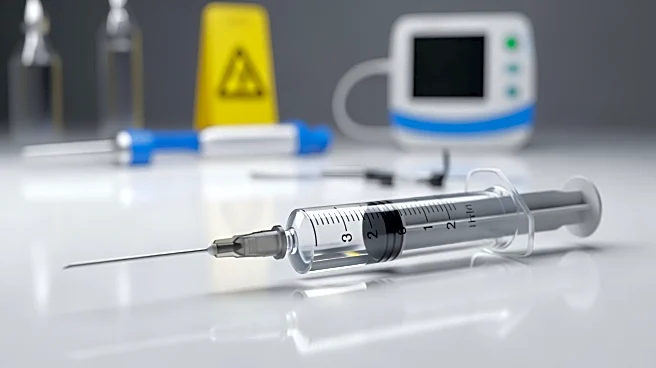What's Happening?
The Ultomiris drug market is projected to grow significantly, reaching a market size of $48.61 billion by 2034, with a compound annual growth rate (CAGR) of 28.5% from 2025 to 2034. Ultomiris, an intravenous
infusion medication used to treat rare autoimmune conditions such as myasthenia gravis, paroxysmal nocturnal hemoglobinuria (PNH), and atypical hemolytic uremic syndrome (aHUS), has been approved by the FDA in the United States. The drug's market growth is driven by its extended dosing regimen, expanding clinical applications, and increasing prevalence of conditions like PNH and generalized myasthenia gravis (gMG). Innovations in long-acting complement inhibitors aim to extend dosing intervals and improve treatment adherence, while formulation advancements are underway to reduce infusion times and support subcutaneous delivery for both adult and pediatric populations.
Why It's Important?
The growth of the Ultomiris market is significant for the healthcare industry, particularly in the treatment of rare autoimmune conditions. The drug's extended dosing intervals and improved treatment adherence can enhance patient quality of life and reduce healthcare costs associated with frequent infusions. The expansion of clinical applications and indications, such as approvals for PNH, aHUS, and gMG, broadens the potential patient base, increasing demand for the drug. Additionally, the integration of digital platforms for patient engagement and the use of artificial intelligence in optimizing dosing strategies highlight the evolving landscape of pharmaceutical innovation. The market's growth also reflects the increasing prevalence of chronic conditions, driving demand for specialized therapies.
What's Next?
The Ultomiris market is expected to continue expanding, with ongoing efforts to explore new indications and improve drug formulations. The focus on subcutaneous delivery methods and pediatric-friendly options could further enhance patient convenience and compliance. As awareness of rare diseases increases, healthcare professionals and caregivers are likely to adopt Ultomiris more widely, particularly in regions with rapid economic growth like Asia-Pacific. Strategic marketing efforts and partnerships by global players will continue to expand awareness among clinicians and treatment centers, potentially leading to greater market penetration. Regulatory approvals and reimbursement pathways will play a crucial role in shaping the drug's availability and uptake.
Beyond the Headlines
The Ultomiris market presents opportunities for broader immunological and hematological applications, potentially expanding its market footprint. The drug's mechanism of action could be leveraged for new therapeutic areas, offering hope for patients with unmet medical needs. The market's growth is also fueled by Ultomiris's potential for offering a significantly longer dosing interval compared to its predecessor, Soliris, enhancing patient convenience and adherence. This longer duration between treatments improves the patient's quality of life and reduces the burden associated with frequent infusions, making it popular in the market. The integration of digital health tools for prescription management and patient support further underscores the shift towards more personalized and efficient healthcare solutions.














